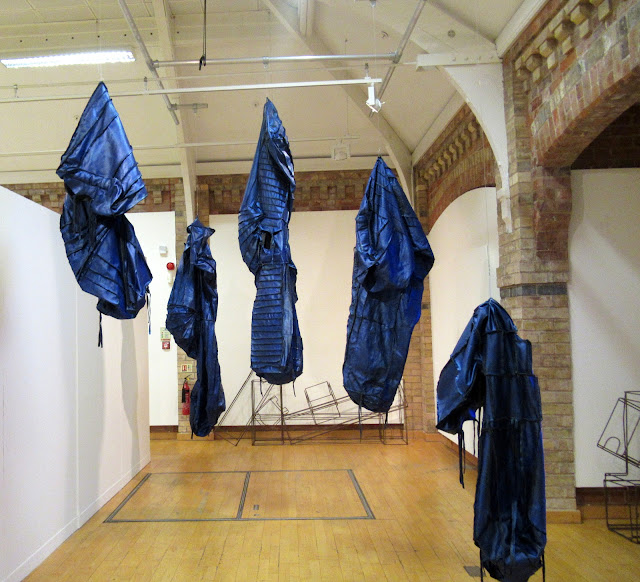Leamington Spa Art Gallery - 25 years
It's been 25 years since the gallery was re-located at the Royal Pump Rooms. To celebrate this, there was a re-hang of the permanent collection, and 25 objects are being showcased as part of the temporary exhibition.
Terry Frost, Untitled, 2003, (painted steel)
When Terry Frost died, he was working on a commission for a large-scale sculpture for the new University Hospital of Coventry and Warwickshire, due to open in 2006. The financial implications were complicated and the commission did not happen. A limited number of small models were produced from the maquette.Alma Ramsey-Hosking, Two Watchers on a Staircase, 1960, (cement fondu and metal)
A real sense of movement is conveyed through the dynamic poses of the figures and the partica spiral staircase.
Bridget Riley, Drawibng R1001, 1971, (gouache and pencil on paper and hardboard)
Riley, an icon of British art in the 1960s, was a key member of the Op Art movement, which was concerned with evoking sensations of movement and had roots in the earlier 20th century artistic groups Dada and the Bauhaus. Riley's work creates fantastic optical effects and forms an enquiry into the evolving artistic relationships between looking, seeing and representation.
Bridgeman's studies at the Colchester School of Art were interrupted by WWII. A consciencious objectotr, Bridgeman worked for the Civil Defence Service rescuing people bombed during the Blitz.
He created figures with distorted heads some devil-like and others suggesting a mutant form of humanity. The most disturbing of all these figures is the one he named The Manipulator. The word itself suggests a sinister distortion of humanity that has consciously deviated from its natural behaviour. The gesture of the figure, with right arm extended and palm held flat against the viewer, suggests a signal to stop.
Dorothy Annan, Sketch For Leamingtonian Life, 1940, (gouache on hardboard)
Leamington Spa was one of the main bases for camouflage research during WWII and during the 1990s Leamington Spa Art Gallery and Museum began acquiring items relating to the work of camouflage staff.
During WWII, communal feeding stations, renamed British Restaurants by Winston Churchill, were set up throughout Britain to provide unrationed meats to those who had been bombed out, lost their ration books or been relocated for war work. In 1942, a group of artists, including Annan, painted a series of murals for Leamington's British Restaurant to encourage a positive and uplifting atmosphere to custoners. Anna's sketch shows her design for the mural depicting a compressed townscape including Jephson Gardens and Royal Pump Rooms.
Alexander Mackenzie, Lakedown, 1962, (oil on board)
Alexander Mackenzie, Lakedown, 1962, (oil on board)
John Piper, (Wolfhamcote Church, 1940s, (oil and mixed media on canvas)
Kialy Tinhgang, Fetisshoes
'Fetissoes' is the dismissive, condenscending word coined by 16th century Portuguese explorers to refer to African religious objects believed to have magical powers, also known as 'fetishes'.
In Fetissoes, Tihngang speculates that a group of enslaved African people have jumped overboard a slave ship. In the water they encounter the master's tools, European maritime technology such as periscopes and diving suits. With these materials they build fetishes for traditional African water deities. These take the form of wearable, 2-metre-tall periscope suits. They invoke the deities' power and protection by ritualistically wearing the suits and are able to re-cross the Atlantic underwater and return home.
The wearable sculptures are failed, defective, prototype versions of the periscope suits, discovered at the bottom of the ocean and hung in a museum-like space rather than repatriated to their countries of origin.
Tim Pomeroy, Little Crown, 2021, (slate)
Frederick Cayley Robinson, Sketch for The Farewell, 1954, (oil on board)
The composition with the heads of figures cropped close in one corner, is repeated in many of the artist's works. These figures seem transitory, easily passing in and out of the image and their intangible nature contributes to the dream-like quality of the work.
Frederick Cayley Robinson, The Bridge, 1954, (oil on board)
The fading nature of the image is a deliberate effect on the part of the artist, who experimented with surface texture, drawing, tinting, adding and removing layers, rubbing and scratching the surface of the work.
Lawrence Stephen Lowry, The Mission Room, 1937, (oil on board)


















I like Bridget Riley, and the 2 watchers on the staircase.
ReplyDeleteThe John Piper is quite interesting and enjoyable.
Nice one.
Riley never disappoints. I too like The Watchers. The Piper is my favourite, I love it. I like the Mackenzie as well.
Delete